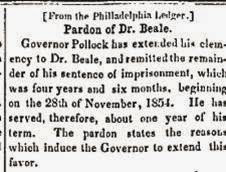Ancestors Distributing Legal Alcohol?
When speaking of the Prohibition Era, we
often overlook our ancestors who legally distributed alcohol-based medicine. However buried amongst the Tempest Movement, the bootleggers, and speakeasies, were doctors, pharmacists, druggists, and patent medicine vendors legally distributing alcohol within this dry nation. Although under close tight regulations, they were allowed to distribute elixirs, tonics, bitters, and other herbal and
fermented concoctions under the auspices
of "medicine.”
 Alcohol was the leading medicine for
many diseases to include cholera. The Temperance movement protested the use of
alcohol in medicines. To be fair, most of these patent medicine elixirs were grossly
laced with alcohol; using high percentages of its content (up to 40%).
Alcohol was the leading medicine for
many diseases to include cholera. The Temperance movement protested the use of
alcohol in medicines. To be fair, most of these patent medicine elixirs were grossly
laced with alcohol; using high percentages of its content (up to 40%).
In Ep:05 of Hittin’ the Bricks
with Kathleen caller Karen Fuller’s brickwall
was complicated by the occupation of “Dr. Fuller,” a patent medicine
vendor. In truth, these elixirs weren’t patented at all – just vegetable
extracts laced with “ample’ doses of alcohol.
But for genealogists and family researchers the papertrail leads us to the possible legal aspects of
the profession which produced federal and state registrations, permits, and licenses And, as the illegal bootleggers were reaping an impressive financial
gain, the occupation of patent medicine vendor, druggist, or pharmacists, or
self- identified “Doctor,” often included prison, court cases, and corruption activity
reviews. So many resources to tracing our ancestors!
Legal or Bootleggers
Remember hearing the song Save A Little Dram for Me? Well, The Volstead Act, aka National Prohibition Act, also allowed clergymen to use wine for sacramental services. Be sure to review the lyrics and catchy tune Save a Little Dram For Me. Farmers, too, could possess up to 200 gallons of preserved fruit which fermented was a solid base for alcohol.
Financial Gain
A law this big did require Prohibition
Commissioner. Perhaps your ancestor worked on the reporting end of the Volstead
Act. During the prohibition, in 1920’s alone, physicians wrote approximately 11
million prescriptions annually. One Prohibition
Commissioner, John F. Kramer, reportedly cited a doctor who wrote 475
prescriptions for whiskey in one day. Kramer was one of 1500 prohibition
agents.
Not only was prohibition profitable for
physicians, but our neighborhood Walgreen’s founder, Charles R. Walgreen, expanded
from 20 stores to 525 during the 1920’s. Although Walgreen attributed their expansion
to the introduction of milkshakes, they became a pharmaceutical empire.
 There was one way to obtain alcoholic beverages
legally during the prohibition years: through a physician's prescription,
purchasing the liquor from a pharmacy. Physicians could prescribe distilled
spirits--usually whiskey or brandy--on government prescription forms.
There was one way to obtain alcoholic beverages
legally during the prohibition years: through a physician's prescription,
purchasing the liquor from a pharmacy. Physicians could prescribe distilled
spirits--usually whiskey or brandy--on government prescription forms.
In
the United States from 1920 to
1933, a nationwide constitutional law prohibited the
production, importation, transportation, and sale of alcoholic beverages. Prohibition
ended with the ratification of the Twenty-first
Amendment, which repealed the Eighteenth Amendment on
December 5, 1933.
Denatured
Alcohol
In college (even in the
1970’s), I was warned not to drink out of the sinks because kool-aid and grain
alcohol could kill. Or make one go blind,
as it did with the cousin of our cousin Pete Tumbleson. Growing up the name of
the cousin of cousin Pete was etched in my head. Visit
the Mob Museum for a full story denatured and unregulated alcohol formulas.
As mentioned, the National Prohibition
Act required licenses, registrations, and approvals. This allowed for legal write
up of prescriptions and scripts for medicinal booze. In other words, a way for
a family historian to trace and learn more of their law abiding ancestors. Our law-abiding
ancestors applied for licenses that gave them the right to issue scripts for
medicinal booze.
 Records for both the
legal distributors of alcohol and the bootleggers, should be retrieved. In addition
to uncovering newspaper searches, local court records and dockets, and local
/state prison records, the following should be reviewed:
Records for both the
legal distributors of alcohol and the bootleggers, should be retrieved. In addition
to uncovering newspaper searches, local court records and dockets, and local
/state prison records, the following should be reviewed:
3 Resources to Begin Researching Your Legal / Not-So Legal Prohibition Era Ancestor
- NARA Records of the Bureau of Prohibition, NARA - Seattle, WA
Responsible for tracking bootleggers and organized
crime leaders - State Records:
Prohibition Commission, ie. Records of the Virginia Prohibition Commission,
1916-1934
- NARA: US Penitentiary (i.e.Ft. Leavenworth), Prohibition Act
Additional Resources
Kathleen Brandt
Be Historically Correct
a3genealogy.com
Accurate Accessible Answers
a3genealogy@gmail.com












%20(LinkedIn%20Post)%20(Instagram%20Post%20(Square))%20(Pinterest%20Pin%20(1000%20%C3%97%201500%20px)).jpg)






